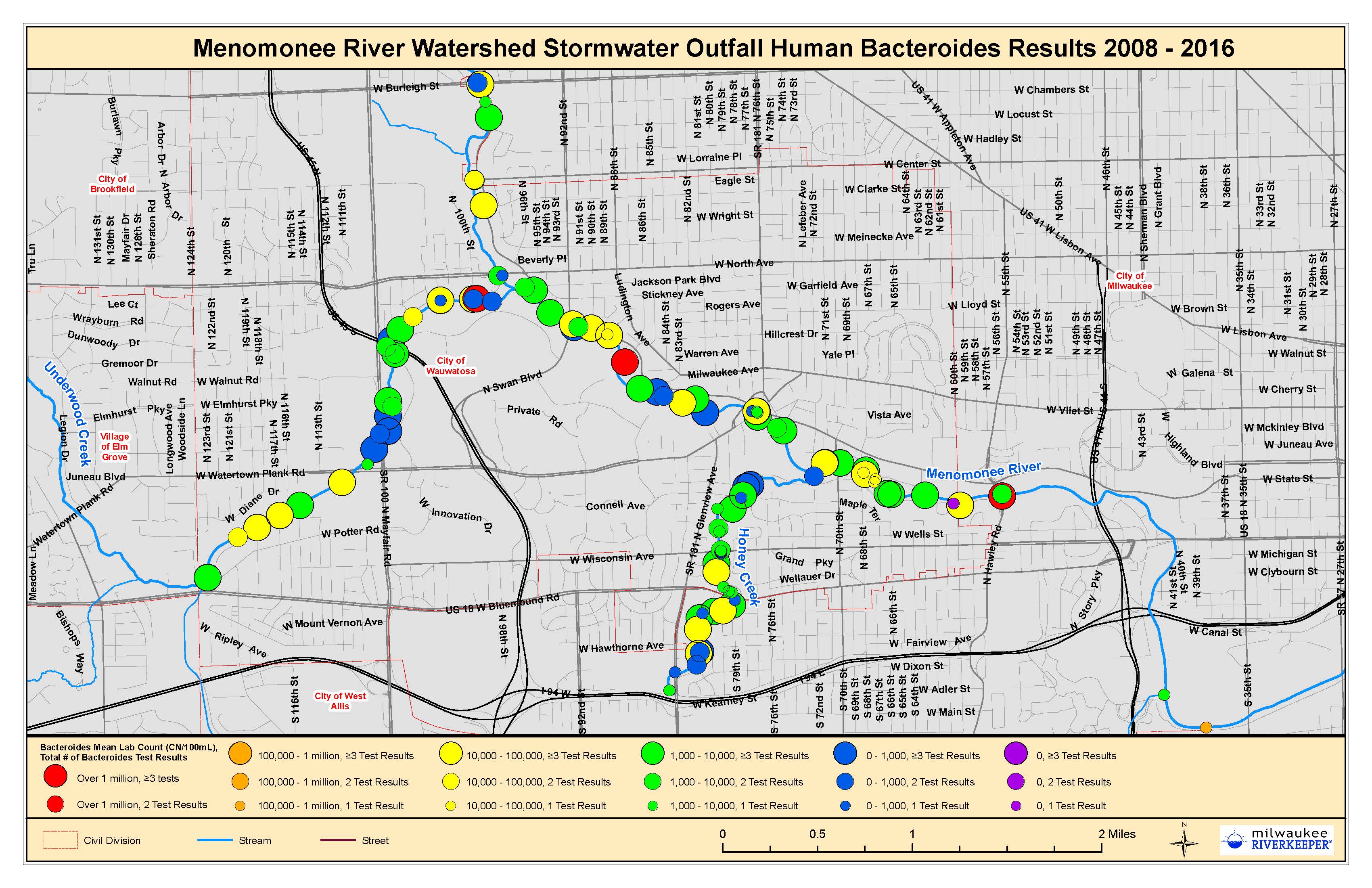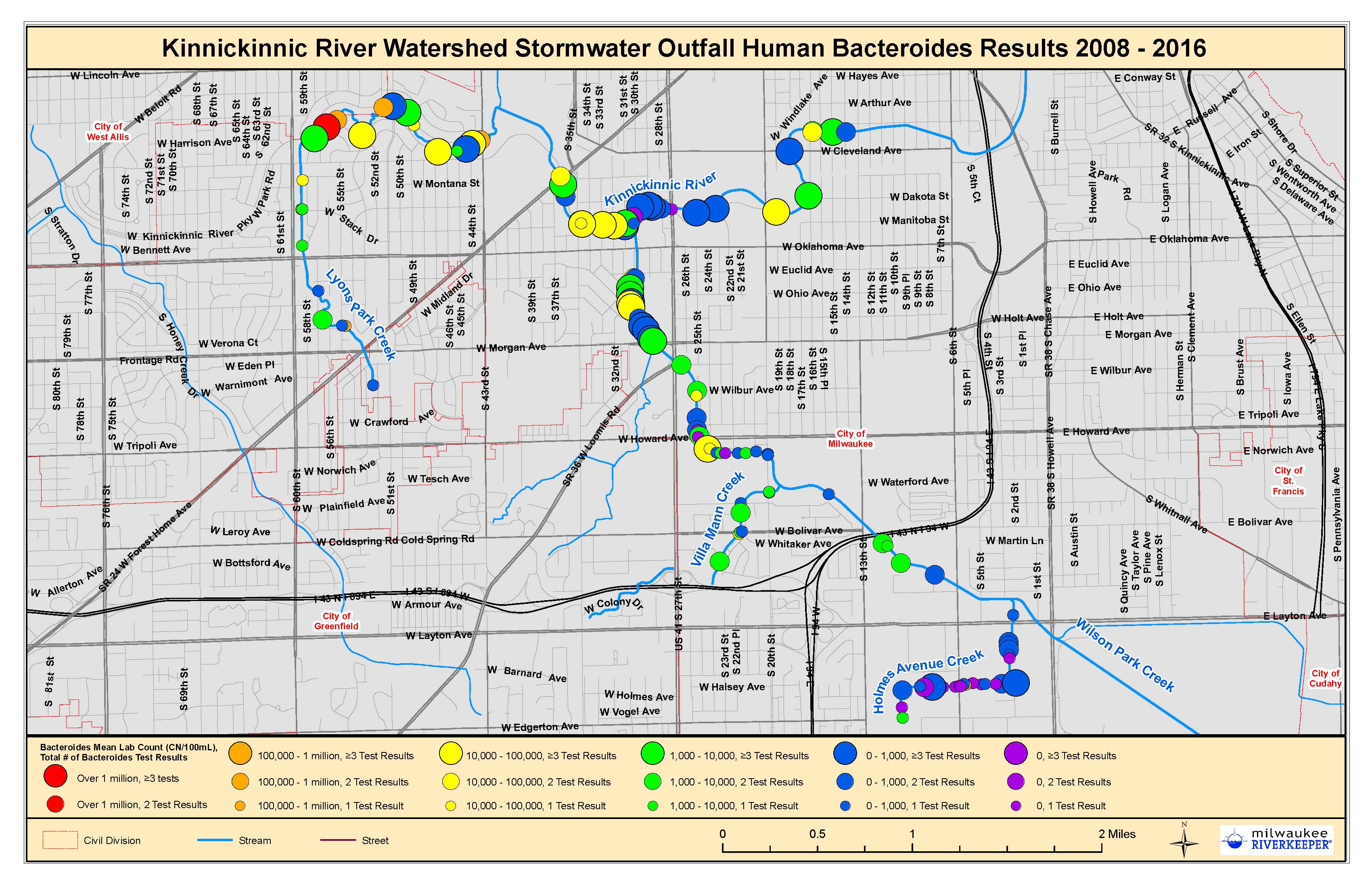Stormwater Monitoring
In Milwaukee, like many cities around the country, centuries-old sewer infrastructure is failing and leaking, and sewage can make its way into our waterways. Sewage contamination, which leads to high bacteria loads, prevents us from achieving the goals set out in the Great Lakes Water Quality Agreement and the Clean Water Act and contributes to Lake Michigan beach closings in the Milwaukee area.
Data shows that bacteria loads in local streams greatly exceed expected amounts from stormwater runoff alone, and these loads have increased over the past two decades. Almost every portion of the Menomonee and Kinnickinnic River within the Milwaukee Estuary is listed as impaired or proposed to be listed for bacteria in recent impaired waters lists approved by US EPA.
Finding Sewage Contamination
Milwaukee Riverkeeper began working with the University of Wisconsin-Milwaukee School of Freshwater Sciences’ Professor Sandra McLellan and her lab in 2008. Dr. McLellan had done past stormwater monitoring work identifying bacteria inputs to the rivers at a small selection of sites. In 2008, we identified and mapped stormwater pipes, and began to monitor for sources of sanitary-sewage contamination in targeted areas of the Menomonee and Kinnickinnic River Watersheds.
We focused on two areas:
- a 10-mile section of the lower Menomonee River where bacteria levels were 10 to 100 fold higher than expected amounts from stormwater runoff alone (per water quality models developed for MMSD and SEWRPC)
- the entire Kinnickinnic River Watershed, which is uniformly high in bacteria loading, starting with the highest loading areas identified by models.
We aimed to collect one dry-weather (if pipes were running) and three wet-weather samples from all stormwater outfalls along bacteria “hot spots” in both watersheds. This work is mostly completed in both hot spot areas, with most of the stormwater outfalls tested multiple times (some pipes were discontinued from further testing for multiple reasons). All stormwater samples have been tested for E. coli, enterococcus and, using DNA analysis, for several human-specific strains of bacteria including Bacteroides and Lachnospiraceae. This type of monitoring was essential to help identify sources of likely sewage contamination, allowing municipalities to better prioritize additional “find and fix” efforts.


Analysis of data from 2008 to 2016 shows that approximately 122 of the 263 stormwater outfalls that were sampled were positive for human-sewage contamination (for both markers or for only Bacteroides, in older samples), which is about 46% of all outfalls tested. Notably, considerable variability existed, depending on the stream, with a high of 68% of outfalls tested on the mainstem of the Menomonee found to be contaminated and 3% of the outfalls on Holmes Avenue Creek (tributary of the Kinnickinnic) testing positive for human sewage (Figure 10). Over 772 total samples were collected and analyzed. In 36 outfalls, human bacteria were found in every sample tested or 100% of the time (depending on sampling techniques used at the time). Given the huge extent of this problem, project partners are focusing efforts on outfalls with consistently high results for human bacteria, and on pipes that flow in dry weather, a sure indicator that these stormwater outfalls are likely discharging sewage to area waterways on a continual basis.Emerging Contaminants in the Milwaukee River Basin.

Fixing Sewage Contamination
The data collected is helping Milwaukee, Wauwatosa, and surrounding municipalities to conduct diagnostic testing of failing stormwater sewer systems, using such methods as dye testing and smoke testing, and to prioritize repair of damaged infrastructure. Over the years of this project, the team worked closely with MMSD to locate broken pipes and illicit connections “up the pipe” that contribute to contamination of our rivers at the stormwater outfall. We retained Environmental Canine Services on several occasions to help find sources of contamination throughout the drainage area for each stormwater pipe. USGS is collaborating with the McLellan lab and other experts to develop a sensor, or water quality meter that more precisely predicts when water contains sewage contamination. During the 8 years of this project, 12 projects have been undertaken to repair some of the worst stormwater pipes.
“Total Maximum Daily Load” pollution reduction plans, targeting bacteria in all three rivers, are in draft form, and will likely be approved by end of 2017. An Implementation Plan will be drafted for these Plans to help solidify best practices and procedures for addressing bacteria pollution in our rivers. Besides failing sewers and illicit connections, other sources of bacteria include failing septic, wildlife, and manure spreading from agriculture. In addition, the Menomonee River Watershed-Based Stormwater Permit, the first such permit in the US, will continue to require municipalities to work together to target sources of bacterial contamination to stormwater sewer systems and the rivers.
The goal of bacteria monitoring is to better understand the flow of bacteria from stormwater systems to local rivers, with an ultimate goal of finding and eliminating the sources of sewage contamination in local rivers. Bacteria, along with associated viruses and pathogens, is threatening public health and keeping local waterways from meeting the “swimmable, fishable” goals of the Clean Water Act. Much work remains, both monitoring and infrastructure repair, but considerable strides have been made toward identifying specific sources of bacterial contamination in our stormwater system, which is the first step to reducing bacteria loading to our rivers and beaches.

Thanks to our amazing project partners!

Thanks to our funders for their generous support of this program!
